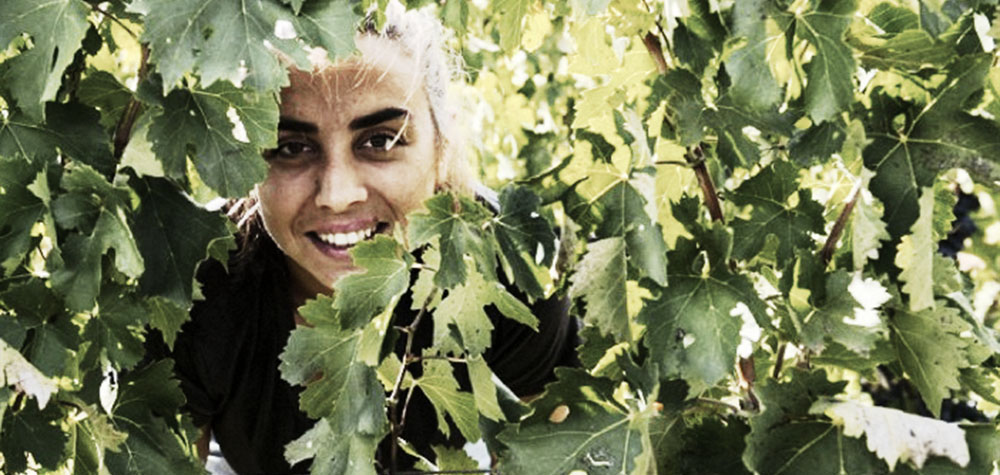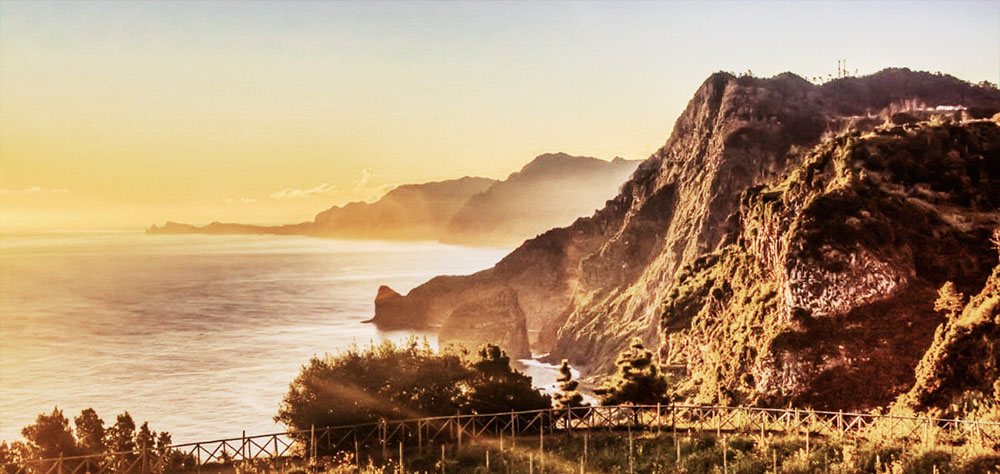*written by someone who has lived on an island for more than 30 years.
The term “maritime climate” is easy to understand. As the name suggests, these are wine-producing regions that are directly affected by their proximity to large bodies of water. Other than sailors, fishers and pirates, no one appreciates or understands maritime life more than those who live and work surrounded by the sea: islanders. Even though some islands don’t technically have a maritime climate (Sicily’s is firmly Mediterranean, for example), wine islands around the globe are more united than you might think. From Tasmania to Madeira to Vancouver Island to Nova Scotia to New Zealand, working with the sea brings a unique set of influences to the wines — and it’s more than just the vineyard.
Viticulturally, the ocean’s moderating properties can be profound, sharing cooling breezes and tempering frost risk — essentially levelling out otherwise hazardous (to vines at least) climate conditions and extending the growing season. Maritime climates are characterized by warm (but not hot) summers, and cool (but not cold) winters — all good things for a vigneron. Seawater takes a long time to warm up in summer, but holds its warm energy long after the surrounding shore has cooled down, helping to moderate the climate into the fall.
However, for all its benefits, a maritime climate is not without risk. As uncontrollable as the sea itself, an oceanic influence can cause veritable shipwrecks in vineyards via damaging wind storms, excessive rain and humidity, which increase the risk of disease.
And island vineyards are also affected by more than climate. The geographical limitation of being surrounded by water generally restricts vineyard size, scaling wineries smaller than their continental cousins. Furthermore, in some parts of the world, viticulture has developed apart from other regions, cultivating grapes and methods unique to the island. One just has to consider the singularity of Madeira for evidence of that. The cost of doing business can also be affected by island living, with everything from dry goods’ transfer in, to ferrying or freighting wine away adding potential costs to the bottom line. Because of quantity and route to market restrictions, plus a generally slower “island time” clock to life, many wineries prefer to cater to their local markets.
While the carbon footprint and personal relationship afforded by close contact with customers is a benefit, it can also be a hindrance to advancing the regions’ quality and recognition. Where is the motivation to sell and excel if your stock is scooped up by your locavore-loving neighbours? Islands are often more challenging to access for tourists as well, unless a flight or a ferry crossing is included in travel plans and budgets. The fewer people who taste your wines, the fewer people will understand you and your region; that’s a fact, no matter where in the world you are. Island life amplifies that.
Smaller-scale, specialized, fresh and unique wines that need to be sought out — it sounds like any sommelier’s dream. So, here are six of the wine islands, and their special wines, that you need to circle in your atlas.
Tasmania
Off the southern coast of Australia and surrounded by the cool Southern Ocean, Tasmania has been rightfully cast as a pristine state for serious and age-worthy sparkling wines and crisp, cool-climate Chardonnay and Pinot Noir. Seven geographical regions produce wine on soils ranging from sandstone and schist in Derwent Valley, to the gravelly basalts of Tamar Valley.
Devil’s Corner Pinot Noir 2014, Tasmania, Australia ($25)
Always excited to see a Tasmanian wine on our shelves, and even more excited to taste it when it’s this interesting. Intoxicating florals, exotic spices, minerality, iron and dried forest on the nose. The palate is textured with stony grip, and layered with smooth and perfumed cassis, black cherry, savoury truffle, subtle cloves and dusky lilacs, supported by worn oak and lifted with brisk acidity. An interesting wine, worth contemplation.
Jansz Premium Cuvée NV, Tasmania, Australia ($28)
Devils aside, this is why Tazzy rules. This cool-climate island is ideal for bright, crisp and high-acid sparkling wine with a gentle cushion of ripe fruit. This “méthode Tasmanoise” is a blend of Chardonnay, Pinot Noir and Pinot Meunier from across the Island. Taut with red apple, cherry and citrus, the palate courts lemon curd and Asian pear before a riff of tight grapefruit and a whiff of herbal anise.
Vancouver Island
Off the far western coast of British Columbia, Vancouver Island is the first land break for the mighty Pacific Ocean’s cooling breezes. The main wine valley, Cowichan, translates to “The Warm Land,” the name given by its First Nations residents hundreds of years ago. It’s a fitting title: the Cowichan Valley has the highest average temperature in all of Canada, creating an ideal growing climate for many things, including vines. Crisp, lighter whites and reds are the norm (Pinot Gris and Pinot Noir leading) as are the use of Blattner hybrids like Cabernet Foch, Epicure and Petit Milo, which are well adapted to the vagaries of climate.

Unsworth Vineyards Pinot Noir 2014, Cowichan Valley, Vancouver Island, British Columbia ($26)
An alluring nose of perfumed black raspberry, forest and fine spice opens this light-bodied Cowichan Valley Pinot Noir. Fermentation in stainless before 16 months in new and used French oak, this is bright, quiet and elegant Pinot. Finely sticky tannins, gently lifted acidity, subtle black cherry and a lick of pink peppercorn spice prove that less is more. Fine florals linger on the finish. Lovely on its own, or pour with more delicate foods, like black tea and wild mushroom poached fish.
Averill Creek Charme de L’ile NV, Cowichan Valley, Vancouver Island, British Columbia ($18)
Pinot Gris and Pinot Noir are branded under the Charme de L’ile name, signifying Charmat method fizz made from island grapes. This is a beauty example, fresh and finessed far beyond your typical Proscecco-styled wine. Light florals, crisp pear, green apple and ample minerality on the lively palate. Kissed with honey and an herbal savoury note on the zesty finish. Fantastic value, very impressive.
Sicily
Sicily has been producing wine for more than 3,000 years, and today’s modern wines are shaped by the island’s indigenous grapes and time-tested traditions. Grillo, Catarratto, Nero d’Avola and Frappato are just four of the 50 grape gems native to this Mediterranean island. The warm, dry climate benefits from coast breezes, keeping mildew low and benefitting sustainable, low-interventionist winemaking.
Occhipinti Il Frappato 2014, IGT Terre Siciliane, Sicily, Italy ($50)
Herbal, perfumed woodsy flowers, this biodynamic frappato is from 50–60-year-old vines grown on Sicilian sands and chalk, at 280 metres altitude. 70% of the wine is macerated for 2 months on its skins, while the other 30% stays on its skins for 8 months. Aged 14 months in large 25HL Slavonian oak barrels before a 1-month stint in bottle before being bottled unfiltered. An herbal, earthy and salty cut lures you into this light-bodied, expressive and beguilingly floral red, one held riveted with fine but ample grippy tannins. Frappato’s florals abound: iris, lilac, blue plum, sap and sweet salami lead the textural, rock-dust palate to the salty mushroom bouillon on the finish. Even better the second day, this intriguing wine is one for adventurous drinkers to return to again and again.

Planeta Etna Rosso 2013, DOC Etna, Sicily, Italy ($30)
This finessed, lifted Nerello Mascalese takes you right to Sicily and the unique volcanic terroir and altitude of Etna DOC. The wine sees 18 days of skin contact before resting in used barriques for 6 months. Perfumed with wild raspberries, herbal anise and cherry aromas. This medium-bodied red is lifted with bright acidity, carrying perfumed violets, cherry, raspberry and bittersweet cocoa across fine-grained, gritty tannins. Minerality seems omnipresent through to the lingering violet-scented, grippy finish. Truffles, salty aged cheese and charcuterie will pair now, or cellar for 3 to 5 years and be rewarded.
Madeira
This rare, fortified, exceptionally long-lived wine is only produced and bottled on a small sub-tropical Portuguese Island in the Atlantic, geographically closer to Morocco than it is to mainland Portugal. Steep and mountainous, Madeira is home to seven different microclimates spanning cold Atlantic to subtropical. Grapes here have evolved over the centuries, with traditional whites Sercial, Verdelho, Terrantez, Bual and Malmsey joined by the sole workhorse black grape, Tinta Negra.
Blandy’s Malmsey Rich 10 Year Old, Madeira, Portugal ($50)
Walnut hued, with flashes of orange. Brandied walnuts, roasted almonds and hazelnut paste aromas carry to the palate, where fine, grippy brisk tannins add structure. Acidity holds the sweetness very well. Worn woods close the finish, along with great white peppery spicing.
Blandy’s Terrantez 1977, Madeira, Portugal ($210)
Deep-brown orange hue. Richer and rounder in the mouth with nut butter, golden raisins, subtle woods, orange oil and nuts. Oxidized, with a slightly off-nut character, though remains fine and graceful on the concentrated palate though the lengthy finish.

Nova Scotia
Its location on the far eastern coast of Canada doesn’t just afford Nova Scotia the cooling sea breezes of the powerful Atlantic Ocean. It was also one of the first land stops for explorers from Europe, which is why vines were planted for wine production as early as the 17th Century, one of the first plantings in North America. With soils carved by the ice age, and marine-hardy hybrid grapes given preferential treatment, the wines of Nova Scotia are as singular as they come. The extended growing season and cool-climate freshness have also provided a spectacular environment for sparkling wines.
Benjamin Bridge Brut Méthode Classique 2011, Gaspereau Valley, Nova Scotia ($45)
This newly released 100% Chardonnay Brut spent 4 years on the lees before its release, and is still extremely tight, fresh and precise. Tasting beauty now, this has a long life ahead. Gripped by a pithy tightness, and centred with a comfortably slender palate, this is crystalline orange and lemon, pear skin and oil, with bitter lemon thistle herbaceousness through to a shimmering vibrato on the finish. Serious stuff.
Jost Tidal Bay 2015, Nova Scotia ($18)
Tidal Bay is an appellation of style, and these wines are meant to reflect the fresh, bright, light atmosphere of coastal Nova Scotia. The whites are L’Acadie Blanc and other white varieties, and cannot exceed 11% alcohol. Jost’s Tidal Bay is splashed with Geisenheim, resulting in perfumed lime blossoms, a light lavender note and off-dry sweetness on a soft, light, lifted palate.
New Zealand
Vibrancy and purity through the length of its slender 1600-kilometre frame from sub-tropical Northland (36°S) to the world’s most southerly grape-growing region, Central Otago (46°S). No vineyard is more than 120 kilometres from the ocean, with warm sunshine hours offset by ocean-cooled evenings. While Sauvignon Blanc dominates, other grapes excel, with Chardonnay, Pinot Noir and Shiraz showing great promise. Very generally, the warmer climates of the North Island’s Gisborne and Hawke’s Bay typically yield fuller-bodied, riper wines with softer acidity, while the cooler South Island shows medium- to lighter-bodied wines, with greater acidity.
Schubert Block B Pinot Noir 2013, Wairarapa, New Zealand ($50)
From the North Island’s Wairarapa Valley, this Pinot Noir was destemmed and fermented into stainless for 3 weeks of maceration before moving to French barriques for 18 months (40% new). Bricking hue, this generous Pinot leads with autumn forest and moss into sun-ripened cherry and black raspberry, mustard seed herbaciousness, fine pepper and cinnamon spicing, and a subtle tar-lined, fleshy palate. Fine, grainy tannins frame the whole to a warm, smoky finish. This packed, Kiwi Pinot will stand up to smoked pork ribs.
No. 1 Family Estate No. 1 Cuvée Blanc de Blancs NV, Marlborough, New Zealand ($40)
Spiced ginger dough, sea salt and frizzed lemon pith open this blanc de blancs, from 100% Chardonnay. The tight, green apple and lemon character has been deepened and matured with 2 years on the lees, but it still retains the marine freshness. Elegant and well integrated.
